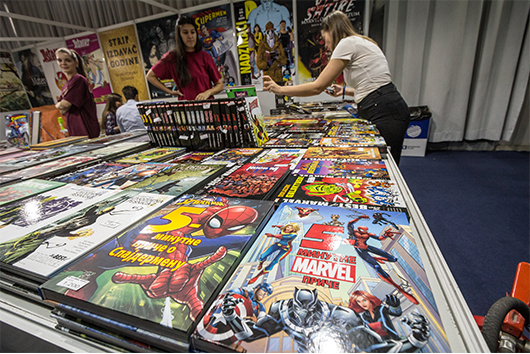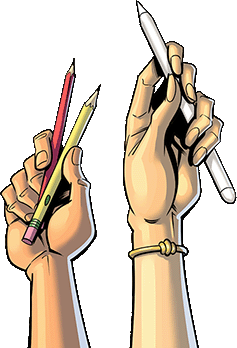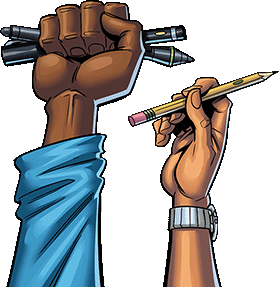How to Make Comics: Ideas, Activities, and Resources for Learning and Making
April 6, 2023
Are you looking for ideas to make a comic book? Comics can be a fun and rewarding way to express creativity and explore new worlds. Comics and graphic novels combine the power of storytelling and visual art, making them a unique and engaging medium. Whether you are a seasoned artist or just starting, creating your own comics can be an exciting and fulfilling experience.
Discover ideas, techniques, and resources to jumpstart your comic book journey. Learn the essentials of character creation, brainstorming, visual style, coloring, and more to bring your comics to life.
Getting Started with Ideas to Create a Comic Book
From the essential materials to understanding different comic formats, here are some tips to help you take your first steps in creating your own comics:
How to Start Making Comics?
The first step in making comics is deciding on a story or idea you want to convey. This can be anything from a personal experience to a fictional adventure. Once you have a concept, it’s time to start putting it on paper. This may involve creating a script or an outline to guide your story. You can also begin to sketch your characters and settings.
Basic Materials Needed
You will need basic materials such as pencils, erasers, paper, and ink pens to create your comics. A tablet and a drawing program like Pixton are ideal for those who prefer digital drawing.
Investing in good quality materials is essential to ensure the best outcome for your artwork. Don’t forget to consider the paper size and format you will use, as this will affect the overall layout of your comic.
Understanding the Different Comic Formats
One of the most common formats is the comic strip, a short, horizontal strip of panels typically found in newspapers. Or you could try a standard comic book, which usually consists of around 24 pages and can be either black and white or in color.
Graphic novels are longer works that typically tell a complete story in a single volume, while Japanese manga format comics usually have a page size of 5” x 7”, with black and white illustrations and unique storytelling. Understanding the different formats will help you choose the best approach for your story and target audience.
Developing Ideas to Make a Comic Book
Finding inspiration for your story can be one of the most challenging aspects of comic book creation. Comics have been in print since 1897, and so many interesting and unique stories have been told in that time. To create a story that will captivate your audience, try some of the following tips:
Brainstorming Techniques
Brainstorming is an essential part of the comic creation process, and there are several techniques to help generate ideas. Creating a mind map, where you write down your main idea in the center of a piece of paper and then branch out with related ideas can be helpful. Or, try using prompts, such as a particular setting or genre, to generate ideas.
Freewriting is also an effective technique. Freewriting involves jotting down whatever comes to mind without judgment or editing. You can then read through what you wrote to choose several great ideas.
You can also collaborate and bounce ideas off friends, family, or fellow creatives. This can help you refine your ideas and develop new perspectives and insights.
Finding Inspiration for Stories
Inspiration can come from many sources, including personal experiences, current events, literature, and pop culture. To find inspiration, try to read widely and expose yourself to different genres, text types, and storytelling styles.
You can also draw inspiration from your life experiences, using your struggles, triumphs, and relationships as the basis for your stories. Another approach is to find a unique angle or perspective on a familiar topic, such as retelling a classic story from a different character's point of view.
Techniques for Creating Believable Characters
Creating believable characters is crucial for crafting compelling stories. One technique is to build character profiles, where you write details about the character’s personality, background, motivations, and relationships. This can help you flesh out the character and make them feel more natural.
Use sensory details to bring the character to life, describing their appearance, mannerisms, and quirks. Giving the character flaws and vulnerabilities makes them more relatable and human. Also, consider the character’s arc throughout the story, how they change and grow, and what challenges they face along the way.
Creating Comics
Creating a comic involves more than just writing a story. It’s about bringing your vision to life through visual storytelling. To make your comic engaging and visually appealing, you need to focus on three critical elements:
Deciding on a Visual Style
Your comic’s visual style makes it unique and sets it apart from others. It’s essential to choose a style that suits the mood and genre of your story. Whether you want a cartoonish or realistic style, make sure that it complements the story you want to tell.
Experiment with different styles and see which one works best for your story. Once you have chosen your drawing style, be consistent throughout the comic, especially if you are developing a series. Changing artistic style part way through a comic can be jarring and alienating for audiences.
Creating Comic Panels and Layouts
Comic panels are the building blocks of your comic. They’re the individual images that tell your story. To create an effective comic, you must carefully consider your panels’ placement and size.
Think about how you want the reader’s eye to move across the page and create layouts that draw the reader in. Pages with panels that are all the same size will slow down the reader, allowing them to pay attention to small details. However, over-using similar-sized panels can make a comic feel bland. Try a combination of panel sizes and shapes and use techniques like splash pages, double-page spreads, and gutters to create visual interest.
Understanding the Importance of Pacing and Flow
Pacing and flow are critical to the success of your comic. You need to keep your reader engaged by balancing action, dialog, and quiet moments. Your comic’s pacing should match your story’s tone and mood. Create a rhythm that feels natural to the reader, and make sure that each panel flows smoothly into the next.
Try panel layouts with blockage (stacking two panels next to a single vertical elongated vertical panel) or staggering to change the reader’s eye line and reading direction. Or, add insets to highlight specific details or show closeups of characters' faces and slow down the reading pace.
How to Write Comics
While creating visuals is essential to making a comic book, it’s not the only element determining its success. In addition to the visual style, comic book creators must also focus on the following:
Writing Dialog
Writing dialog for a comic differs from writing dialog for other mediums. Since you’re working with limited space, keeping the dialog concise and impactful is crucial. A well-written dialog can reveal the characters’ personalities, motivations, and relationships.
For example, consider the famous comic book character Spider-Man. His quippy one-liners during fight scenes perfectly reflect his character's personality as a wisecracking hero.
Balancing Dialog and Visuals
The visuals and dialog in a comic book are interdependent. The visuals should work hand in hand with the dialog to convey the story. However, it’s also vital to ensure that the visuals don’t overpower the dialogue and vice versa. The balance between the two is crucial to ensure the reader’s engagement.
Take, for instance, Frank Miller’s “ The Dark Knight Returns.” Miller’s artistic approach impeccably complements the comic’s somber and edgy tone, enhancing the story’s tension and drama.
Creating a Compelling Story
The story is the core of the entire comic, and it can determine the success or failure of the project. It’s crucial to create an engaging, well-plotted, and coherent story. Conflict is a critical component of a compelling story. Conflict adds tension and drives the story forward, whether external or internal. Without conflict, the story can feel flat and uninteresting.
The stakes in the story should also be high enough to maintain the reader’s interest. Even if the stakes are not catastrophic, they should still be significant enough to keep the reader invested in the outcome. If the stakes are too low, the story may feel unimportant and unexciting, leading to disengagement.
How to Draw Comics?
Drawing is a fundamental aspect of creating a comic book. To draw comics effectively, you need to focus on three crucial elements:
Basic Drawing Techniques
To create a polished and professional-looking comic, it’s essential to master basic drawing techniques, even using digital drawing tools like Procreate or Clip Studio Paint. These include anatomy, perspective, shading, and line work. Understanding anatomy is vital for creating realistic and believable characters in your comics.
Perspective is essential for creating depth and dimension in your scenes. Shading and line work are crucial for creating visual interest and emphasizing details.
Developing a Distinct Visual Style
A distinct visual style is crucial to creating a memorable and engaging comic book. Your visual style should reflect the tone and mood of the story, and it should be appropriate for the target audience.
A distinct visual style can help your comic stand out and make it more memorable. It can also help you communicate the emotions and themes of your story more effectively.
Practice Drawing Techniques
Even if you have never drawn a comic, there are numerous simple ways to get started and hone your craft. Try drawing from a reference. Look at other artists’ work and try to replicate it. This will help you understand how they use elements like panels, speech balloons, and character expressions.
Practice sketching every day. Sketching is an excellent way to improve your drawing skills. Try sketching daily scenes or characters quickly. Focus on simple linework, then look at where the light comes from to find the right places to add shading. Don’t worry about making mistakes; focus on getting your ideas on paper.
Inking and Coloring Ideas to Create a Comic Book
Once you have your comic book drawings ready, the next step is to ink and color them. This is where your artwork truly comes to life. Inking and coloring comics require a different set of skills than drawing, including:
Understanding the Basics of Inking
Inking is the process of tracing over pencil lines with ink to create a clean and polished final line work. Inking requires a steady hand, a good eye for detail, and a solid understanding of line weight and thickness. Using the right tools, such as pens and brushes, is also essential for achieving a professional look.
Different Techniques to Add Depth to the Artwork
Once you have your inked artwork ready, the next step is to add depth and texture to the illustrations. You can use several techniques like cross hatching, stippling, and screen tones.
Cross hatching is the process of creating overlapping lines to create shadows and texture. Stippling involves creating tiny dots to create a textured effect. Screen tones are pre-printed sheets of adhesive film that you can apply to your artwork to create a specific effect.
Tips for Choosing Color Palettes
Choosing the right color palette for your comic is crucial to creating the right mood and atmosphere for your story. Different color palettes evoke different emotions and moods, and it’s essential to choose the right one to match the tone of your story.
Some tips for choosing color palettes include using complementary colors, limiting your color palette to create a consistent look, and experimenting with different color schemes.

Publishing and Sharing Comics
Once you have created your comic, the next step is to publish and share it with the world. Some of the best ways to get your comic out there include:
Finding the Right Platform to Publish Comics
Once you have completed your comic and are ready to share it with the world, it’s important to consider the right platform to publish it.
Digital platforms offer a global reach and the potential for a larger audience, but it’s important to keep in mind that they may take a cut of your profits. Self-publishing allows for more creative control and ownership of your work, but it also requires more effort in terms of marketing and distribution. Traditional publishing can offer wider distribution and support but may also involve giving up creative control.
If you’re looking for a convenient way to publish and sell your comics, consider Comix Well Spring. Our online marketplace provides a platform for selling your work directly to customers. To begin, simply place an order for at least 25 prints with the “Store at CWS warehouse” shipping option.
Once your inventory is ready, sign up as a vendor, enter your print order number, and select your subscription pack. This lets you focus on your creative work while we print and ship your comics.
Marketing Strategies for Comics
Once your comic is published, it’s crucial to have a solid marketing strategy to get it in front of potential readers. This can include social media advertising, attending conventions and signings, and reaching out to comic book bloggers and reviewers for reviews and features.
Comix Well Spring also offers additional printing services such as banners, stickers, bookmarks, and vinyl banners to help you promote your comic book at trade shows or signings.
Strategies for Community Building
Building a community around your comic can also be an effective marketing strategy. This can include creating a newsletter for your readers, engaging with fans on social media, and hosting events such as Q&A sessions or live drawing sessions.
By fostering a strong community, you can create a loyal fanbase that will not only support your current work and spread the word about your future projects.
Resources for Learning and Making Comics
Whether you’re a beginner or an experienced comic artist, there’s always something new to learn and explore. There are numerous excellent resources to help you on your comic book journey, such as:
Comic Books and Graphic Novels to Study and Enjoy
One of the best ways to learn how to make comics is to read them! Study the work of successful comic writers and artists to understand their storytelling techniques and visual styles. Some of the most famous examples of quality comic writing and drawing include Brian K. Vaughan’s Saga and Marjane Satrapi’s Persepolis. These two graphic novels showcase how captivating writing and stunning artwork can make a compelling comic book.
One more great example of a quality comic book series to study is Neil Gaiman’s The Sandman. It is considered one of the most influential and groundbreaking comic book series of all time. The series features an intricate storyline with complex characters and beautiful artwork by some of the industry’s leading illustrators, including Jill Thompson, Mike Dringenberg, and Michael Zulli. The Sandman also demonstrates the power of using mythology and folklore in comic book storytelling.
Websites, Blogs, and Social Media Accounts to Follow
Many blogs and social media accounts are dedicated to the art and craft of comic making. If you’re an aspiring comic creator, following blogs and social media accounts like these can be beneficial. They can provide insights into the creative process, techniques for drawing and storytelling, and inspiration for your projects.
Gail Simone’s #ComicsSchool website is an excellent resource for aspiring comic book writers. Using the #ComicsSchool hashtag on Twitter, Simone offers valuable advice for beginning comic book writers and compiles all her tips on the website. It’s a great place to start if you’re just starting and looking for guidance.
Rob DenBleyker, co-creator of the webcomic Cyanide & Happiness, is another excellent resource for aspiring comic book writers. With his dark humor and irreverent take on modern life, DenBleyker has amassed a large following on social media. He frequently interacts with fans, offering advice and glimpses into his creative process.
At Comix Well Spring, we understand the importance of resources for budding comic book artists. That's why we offer a range of great resources on our website to help support aspiring comic book creators get started. From printing tips and tricks to design templates, our website is a one-stop shop for all your comic book printing needs.
Courses, Workshops, and Events for Aspiring Comic Creators
For those who want a more structured approach, courses, workshops, and events are available for aspiring comic creators. Attending comic conventions like the San Diego Comic-Con and events like Small Press Expo is an excellent way to connect with other creators and learn from industry professionals.
Many comic cons offer workshops and panels on various aspects of comic book creation, from writing to drawing to publishing. Keep an eye out for events in your area, and don't be afraid to network with other creators and ask for advice.
Online platforms like Masterclass and Skillshare also provide accessible and affordable courses for learning new skills from the comfort of your own home. For example, Comics & Graphic Novels from Gotham Writers Workshop is an intensive online/offline course designed for aspiring comic creators of all levels to learn the essentials of comic book storytelling.
Bring Your Vision to Life
Creating a comic book is a creative and fun journey anyone can embark on. You can create a unique and captivating comic book with the right ideas, techniques, and resources. If you’re ready to take the next step and bring your comic book to print, partner with Comix Well Spring.
With high-quality printing services and various available resources, Comix Well Spring can help you create a professional-looking comic book that accurately represents your vision. Contact Comix Well Spring today at (734) 927-0044 to learn more about our professional services and get started on these ideas to make a comic book to see where your creativity takes you.


